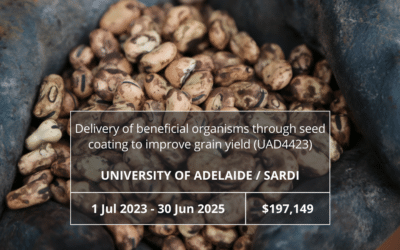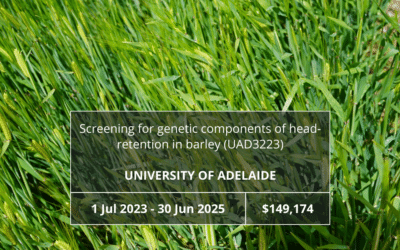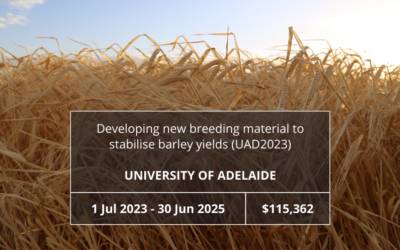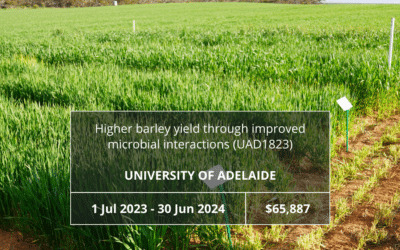This project will be undertaken by SARDI researchers with the optimal flowering period for wheat and barley for the Murray Plains to be refined and validated from previous investment S/UA1021 through field trials and crop modelling. Drone imagery will be used to estimate both plant establishment and biomass of these field trials to help dissect key grain yield drivers independent of flowering time.
Posts Tagged - barley
Delivery of beneficial organisms through seed coating to improve grain yield (UAD4423)
Nov 23, 2023 | Current Projects
This is a pilot project focused on seed quality improvement and enhanced grain production in wheat, barley, chickpea and canola as major diverse crops in SA. This will be achieved by generating new formulas for seed coating that enhance the delivery of Trichoderma, mycorrhizal fungi and other beneficial microbes, nutrients and other effective additives.
Screening for genetic components of head retention in barley (UAD3223)
Nov 23, 2023 | Current Projects
Barley head loss is an ongoing issue that leads to reduced yield based on environmental factors and cultivar sensitivity. Although management options exist, improved genetic solutions are needed to limit the seasonal and site variability. In this project, researchers will extend current knowledge of head loss management and peduncle structure to consider new cultivars and candidate genes that might influence head retention.
Developing new breeding material to stabilise barley yields (UAD2023)
Nov 23, 2023 | Current Projects
South Australian crops can be severely impacted by poor and variable growing conditions, which includes low-fertility soils. Crop plants possess strong instincts to reduce grain number due to variable growing conditions or reduced fertiliser. This is a major contributor to the yield gap in SA. This project seeks to help close this yield gap through the import and testing of new genetic material that makes barley less responsive to environmental conditions.
Higher barley yield through improved microbial interactions (UAD1823)
Nov 23, 2023 | Current Projects
The aims of this project are to determine whether Australian barley varieties differ in their effects on the diversity of potentially beneficial soil microbes in the field, and to investigate the genetic control of any observed differences. This will result in growers being able to choose varieties that will benefit soil biological health and provide new molecular tools for breeders to use in selection to develop new varieties with improved soil biological health.
Latest Media
- 2024 Student Compendium
- Strategies for mitigating frost damage in the Upper North region (UNF1724)
- An improved and rapid test to inform sodic soil management (UAD4624)
- Increasing pulse yields: focus paddocks to identify and manage soilborne constraints (UAD2624)
- Multi-scale monitoring of pests and beneficial insects in canola cropping (UAD1424)





